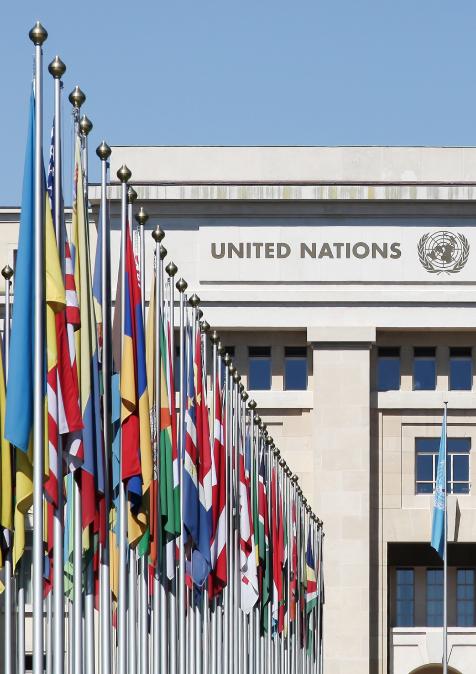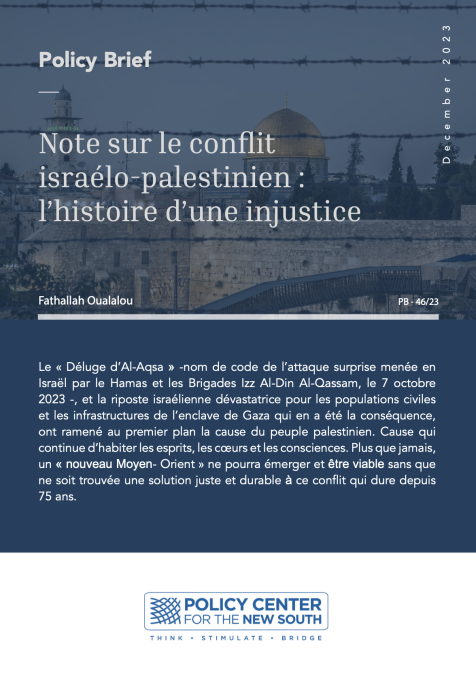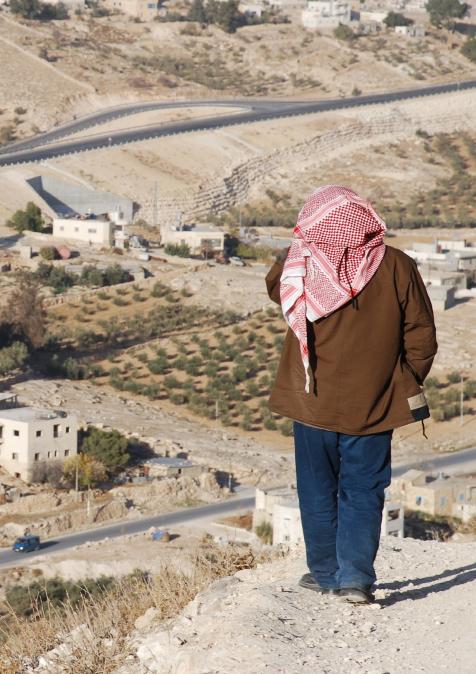Publications /
Opinion
History is unfolding before our eyes. These are days that could define the future of our world. The United Nations is calling for a “Summit for the Future,” promising “Multilateral Solutions for a Better Tomorrow.” This vision will take shape on September 23-24, 2024, in New York City. António Guterres, the Secretary-General of the UN since January 2017, has championed this summit as “a once-in-a-generation opportunity to reinvigorate global action, recommit to fundamental principles, and further develop the frameworks of multilateralism so they are fit for the future.” A chance for the world, but haven’t we heard such lofty principles before? Yes, we can. But the question remains—can we?
Ferid Belhaj, former World Bank Vice President for the Middle East and North Africa, astutely notes in his Policy Brief, published by the Policy Center for the New South, that “the United Nations has a storied history of summits and conferences, each with varying degrees of success. From the Earth Summit in 1992 to the Millennium Development Goals and the subsequent Sustainable Development Goals, the UN has consistently strived to galvanize international action to tackle global challenges.” But Ferid Belhaj poses a critical question: “Are we looking at real prospects for development, or yet another hoax?”
In New York, 193 UN member nations—representatives of a desperately divided planet—will convene for just two days to debate urgent issues: climate action, inequality, digital economies, reforming global institutions, artificial intelligence, and the strengthening of global governance. To survive or not to survive—that seems to be the Shakespearean question as the agenda touches on nearly every major threat to the planet, except wars, terrorism, and oppression. Ambitious? Yes. But is it attainable?
As Washington obsesses over who will next occupy the White House, Vladimir Putin faces a foreign invasion not seen since the Nazi threat to Stalin's regime, Beijing menaces Taiwan with war, Gaza lies in ruins, and Ukraine's devastation dominates global headlines for a third year. Meanwhile, a digital tsunami is sweeping through the UN's concerned departments—proposals, rejections, and debates are in full swing. Political pressure must be resisted, diplomatic blackmail detected, and compromises negotiated. Two days in September to save the world? Or is it merely "enough time to prepare the world for the emerging and largely unpredictable challenges of the twenty-first century," as Belhaj suggests in his Policy Brief, drawing on his experience as Chief of Staff to the President of the World Bank Group?
1- In your Policy Brief published by the Policy Center for the New South, you argue that the summit’s success hinges on the concerted efforts of the international community to turn aspirations into reality. But even with the will, is it possible to find constructive solutions?
The success of the UN-led Summit for the Future, scheduled for September 22-23, 2024, hinges on the international community’s ability to convert aspirations into concrete actions. However, translating political will into practical solutions is fraught with challenges. Historically, global summits have often resulted in ambitious declarations but have fallen short in implementation due to conflicting national interests, insufficient funding, and a lack of enforcement mechanisms. For the Summit for the Future to avoid this fate, as I mention in my paper, it must confront these obstacles directly by ensuring accountability, securing sustained financial commitments, and fostering inclusive participation, particularly from developing countries.
Moreover, the Summit must prioritize actionable frameworks that connect global goals to local realities. The emphasis on addressing youth unemployment, human capital development, and climate resilience is a step in the right direction. However, without robust monitoring and evaluation mechanisms, these efforts risk remaining purely rhetorical.
2- Will the UN members succeed in finding multilateral solutions and real prospects for sustainable development, or will this summit end as “Yet Another Hoax,” as you caution in your paper?
Skepticism persists due to the UN’s history of lofty promises and limited follow-through. Without binding agreements and genuine political will, the summit indeed risks becoming “Yet Another Hoax.” The track record of previous summits and international declarations has often been marred by delayed implementation and unmet goals. Therefore, the summit’s success will ultimately hinge on its ability to move beyond rhetoric to deliver tangible, impactful action that holds all members accountable. From where I stand today, I wouldn’t bet much on a decisive step forward, given the very fragile international order and the various tensions undermining peace and stability around the world.
3- Can you highlight previous summits or conferences that ended as hoaxes, and explain why?
Several UN summits—including some in which I participated—have been criticized as empty promises, where grand declarations failed to translate into concrete action. The 2009 Copenhagen Climate Summit, for instance, was billed as a decisive moment in the fight against climate change but ended in disappointment. Despite high expectations, the summit concluded with a non-binding accord lacking specific targets, leading many to accuse world leaders of prioritizing national interests over global cooperation.
Similarly, the 2005 World Summit, which aimed to reform the UN and address global challenges like poverty and human rights, fell short of its ambitious goals. The summit produced vague commitments rather than actionable strategies, revealing deep divisions among member states. The lack of enforcement mechanisms and follow-through led critics to label it as another example of diplomatic theater.
Another example is the 2002 World Summit on Sustainable Development in Johannesburg, which sought to address the imbalance between economic growth and environmental protection. While the summit did highlight the need for sustainable practices, the resulting Plan of Implementation was criticized for being toothless and failing to hold governments accountable.
The UN’s Sustainable Development Goals (SDGs) have become emblematic of the gap between global ambition and actual progress. Launched in 2015, the SDGs set a roadmap to address critical global issues by 2030, including poverty, inequality, climate action, and sustainable development. However, many goals remain unmet, exposing the limitations of international commitments.
For instance, SDG 1, which aims to eradicate poverty, has seen setbacks due to economic crises, conflicts, and the COVID-19 pandemic. Despite initial progress, the World Bank estimates that over 600 million people will still live in extreme poverty by 2030. Similarly, SDG 13 on climate action has faltered, with global emissions continuing to rise, and key countries failing to meet their climate pledges. This failure echoes the disillusionment of the 2009 Copenhagen Climate Summit.
SDG 10, focused on reducing inequality, has also seen limited progress, with wealth disparities widening in many regions. These unmet goals reflect broader systemic issues within UN-led initiatives, where ambitious targets are set without sufficient political will, resources, or enforcement mechanisms to ensure their realization. Consequently, these summits and goals, despite their noble intentions, often end up as symbolic gestures rather than catalysts for meaningful change.
The Financing for Development (FFD) summits, designed to secure financial commitments for global development, have often been criticized for their lack of tangible outcomes. I will be writing a paper on this topic ahead of the next FFD summit in Spain in June 2025.
These examples underscore a pattern where UN summits raise expectations but ultimately fail to deliver substantial progress, leading to widespread disillusionment.
4- Which global agreement emerging from the September summit would you consider a success?
Given the current state of global affairs concerning peace and security, with numerous conflicts and tensions, a successful agreement in this domain would offer a glimmer of hope. Such an agreement would likely require a robust framework for conflict prevention and resolution, coupled with a commitment from major powers to reduce arms proliferation. An ideal outcome could be a new or reinforced global compact on peacebuilding that emphasizes inclusive governance and addresses the root causes of conflicts, such as inequality and human rights violations. If the summit results in tangible pledges to enhance the UN’s peacekeeping capabilities or to fund regional peace initiatives, it could be considered a success.
In the context of poverty reduction, success would mean an agreement that goes beyond rhetoric, including measurable targets backed by financial commitments from developed countries. This might involve a renewed focus on the Sustainable Development Goals (SDGs), particularly Goal 1 (No Poverty), with concrete plans for financing and implementation. If the agreement includes debt relief for the most vulnerable nations or new funding mechanisms for social protection programs, it will mark a significant step forward.
Regarding climate, a successful agreement would likely feature enhanced commitments under the Paris Agreement, with countries agreeing to more ambitious Nationally Determined Contributions (NDCs) and a clear path to achieving net-zero emissions by 2050. Success would also be measured by the establishment of a robust climate finance mechanism to support adaptation and mitigation efforts in developing countries.
In summary, a truly successful outcome from the summit would be an integrated approach that addresses the intersections between peace, security, poverty reduction, and climate, with enforceable commitments and mechanisms to hold countries accountable. But please, don’t hold your breath...
5- Do you agree with the sentiment that this summit is too ambitious and the agenda too overloaded to secure credible and respected deals?
The sentiment that the Summit for the Future might be too ambitious and overloaded is not unfounded, especially given the current geopolitical context. Major global summits often struggle to balance ambitious agendas with the practicalities of achieving meaningful outcomes. When agendas are overloaded, there’s a risk that critical issues won’t receive the focused attention they require, leading to diluted results.
This challenge is further exacerbated by ongoing geopolitical tensions that strain international cooperation. The fragmentation of global alliances, heightened competition between major powers like the United States and China, and regional conflicts have all contributed to a more polarized international environment. This polarization, coupled with a retreat from multilateralism, undermines the ability to reach consensus on key global issues.
6- Given the urgency of climate change, wouldn’t another global climate conference make more sense, as this summit has limited time to conclude meaningful measures?
Another global climate conference might seem logical. However, past climate events, such as COP summits, have often struggled to deliver impactful measures due to fragmented commitments and implementation gaps. While additional conferences could raise awareness and encourage action, the real challenge lies in translating high-level agreements into effective, actionable policies. The focus should be on strengthening existing frameworks and ensuring rigorous follow-through on commitments to effectively address the climate crisis.
7- The restructuring of international organizations like the WHO, World Bank, and IMF is on the September agenda. Isn’t it overdue and urgent to reorganize the UN itself?
As you know, I recently published a paper on the need for restructuring the now 80-year-old Bretton Woods institutions (The Shift from Multilateralism to Plurilateralism: A Challenge for the Bretton Woods Institutions and the UN as They Turn 80? Ferid Belhaj, May 28, 2024). I strongly believe that the international rules-based system needs revamping. There is widespread recognition that the current multilateral system, particularly institutions like the United Nations, the World Bank, and the IMF, requires reform to better address 21st-century challenges such as climate change, inequality, and emerging security threats. Many developing countries have been vocal about the need for a more inclusive system that gives them a greater voice in global governance.
Thus, a reform of the multilateral system emerging from the UN-led Summit for the Future could be an important outcome, but it would face significant challenges. In my view, and to be realistic, instead of wholesale reform, the summit might result in more incremental changes. These could include:
- Strengthening the role and capacity of the UN in areas like climate action or peacebuilding.
- Creating new mechanisms or coalitions within existing institutions to tackle specific issues, such as debt relief or digital governance.
- Enhancing the representation of developing countries in global financial institutions through governance reforms in the IMF or World Bank.
8- During the tragic conflict in Israel/Palestine, the UN has appeared paralyzed. In peace or ceasefire negotiations in Qatar or Cairo, or the exchange of hostages and prisoners, the UN seems absent. Are its efforts as a buffer force in such conflicts ineffective?
In the current Gaza crisis, the UN’s efforts to mediate and manage the situation have faced significant challenges due to the influence of major UNSC permanent members. The UN has attempted to facilitate peace talks and provide humanitarian aid, but its actions are often constrained by the geopolitical interests of UNSC members, particularly the United States.
The US, a key ally of Israel and a permanent member of the UNSC, plays a significant role in shaping the international response to the Gaza conflict. This involvement can lead to situations where resolutions or actions proposed by the UN are blocked or compromised due to US interests. For instance, US opposition can prevent the UN from adopting measures that might be seen as critical of Israel or that could significantly alter the status quo.
This dynamic contributes to the perception that the UN is ineffective in addressing the crisis. Despite efforts to broker ceasefires or manage humanitarian relief, the impact of UNSC deadlock—driven by the interests of its permanent members—can undermine the UN’s role as a mediator and crisis manager. As a result, the UN’s capacity to address the immediate needs of those affected and to facilitate a sustainable resolution to the conflict can be severely limited.
9- Since its establishment in October 1945, the UN has been seen as an organization with moral authority, ready to assure peace by deploying troops or conflict negotiators. Yet, it remains invisible at the borders between Bangladesh and Myanmar, where the Rohingya are threatened, and in Ukraine, where civilians are bombed. Is the UN failing in its peacekeeping mandate?
While the perception of the United Nations’ peacekeeping efforts may suggest failure, particularly in high-profile conflicts such as the Rohingya crisis and the ongoing war in Ukraine, this view overlooks the complex realities of peacekeeping operations. The UN’s effectiveness is often constrained by factors such as political will, operational limitations, and the nature of the conflicts themselves.
Nevertheless, there are numerous instances where UN peacekeeping forces and negotiators have played a crucial role in maintaining stability and fostering peace. For example, in Western Sahara, MINURSO has provided vital monitoring and mediation despite ongoing disputes. In Lebanon, UNIFIL has contributed to a measure of stability along the border with Israel, even amid current flare-ups and the real risk of an uncontrolled slide toward widespread conflict. The UN missions in Sudan (UNMIS), Burundi (ONUB), Côte d’Ivoire (UNOCI), Liberia (UNMIL), the Democratic Republic of the Congo (MONUC), and the Ethiopia-Eritrea border (UNMEE) have also demonstrated the UN’s capacity to manage complex peacekeeping and nation-building tasks, often under challenging conditions.
These examples illustrate that while the UN’s peacekeeping efforts may not always achieve immediate or complete success, they remain a critical component of international peace and security, working to mitigate conflict and provide support in volatile regions.











